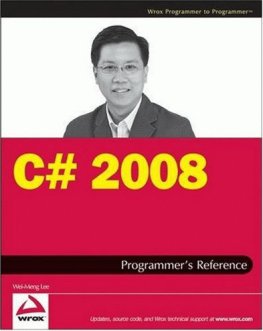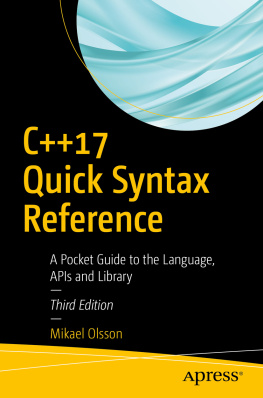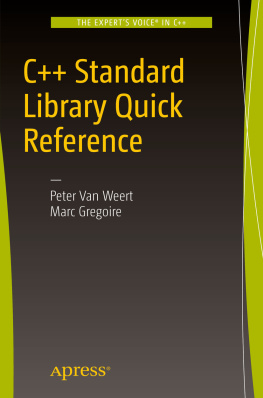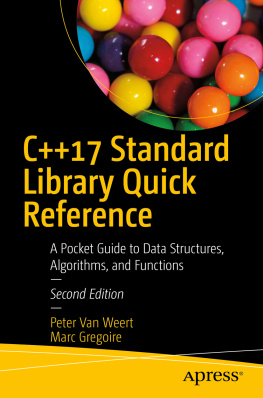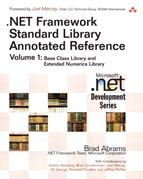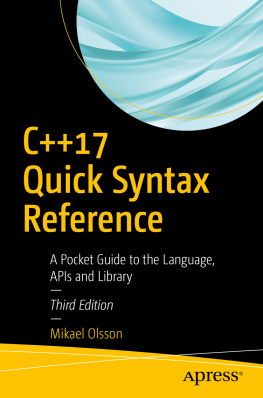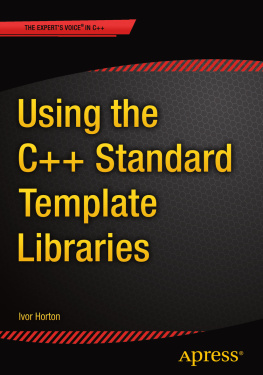Standard Template Library Programmer's Guide
Here you can read online Standard Template Library Programmer's Guide full text of the book (entire story) in english for free. Download pdf and epub, get meaning, cover and reviews about this ebook. genre: Computer. Description of the work, (preface) as well as reviews are available. Best literature library LitArk.com created for fans of good reading and offers a wide selection of genres:
Romance novel
Science fiction
Adventure
Detective
Science
History
Home and family
Prose
Art
Politics
Computer
Non-fiction
Religion
Business
Children
Humor
Choose a favorite category and find really read worthwhile books. Enjoy immersion in the world of imagination, feel the emotions of the characters or learn something new for yourself, make an fascinating discovery.

Standard Template Library Programmer's Guide: summary, description and annotation
We offer to read an annotation, description, summary or preface (depends on what the author of the book "Standard Template Library Programmer's Guide" wrote himself). If you haven't found the necessary information about the book — write in the comments, we will try to find it.
Unknown: author's other books
Who wrote Standard Template Library Programmer's Guide? Find out the surname, the name of the author of the book and a list of all author's works by series.
Standard Template Library Programmer's Guide — read online for free the complete book (whole text) full work
Below is the text of the book, divided by pages. System saving the place of the last page read, allows you to conveniently read the book "Standard Template Library Programmer's Guide" online for free, without having to search again every time where you left off. Put a bookmark, and you can go to the page where you finished reading at any time.
Font size:
Interval:
Bookmark:
Introduction to the Standard Template Library
The Standard Template Library, or STL, is a C++ library of container classes, algorithms, and iterators; it provides many of the basic algorithms and data structures of computer science. The STL is a generic library, meaning that its components are heavily parameterized: almost every component in the STL is a template. You should make sure that you understand how templates work in C++ before you use the STL.
Containers and algorithms
Like many class libraries, the STL includes container classes: classes whose purpose is to contain other objects. The STL includes the classes vector, list, deque, set, multiset, map, multimap, hash_set, hash_multiset, hash_map, and hash_multimap. Each of these classes is a template, and can be instantiated to contain any type of object. You can, for example, use a vector in much the same way as you would use an ordinary C array, except that vector eliminates the chore of managing dynamic memory allocation by hand.
vector v(3); // Declare a vector of 3 elements.
v[0] = 7;
v[1] = v[0] + 3;
v[2] = v[0] + v[1]; // v[0] == 7, v[1] == 10, v[2] == 17
The STL also includes a large collection of algorithms that manipulate the data stored in containers. You can reverse the order of elements in a vector , for example, by using the reverse algorithm.
reverse(v.begin(), v.end()); // v[0] == 17, v[1] == 10, v[2] == 7
There are two important points to notice about this call to reverse . First, it is a global function, not a member function. Second, it takes two arguments rather than one: it operates on a range of elements, rather than on a container. In this particular case the range happens to be the entire container v.
The reason for both of these facts is the same: reverse, like other STL algorithms, is decoupled from the STL container classes. This means that reverse can be used not only to reverse elements in vectors, but also to reverse elements in lists, and even elements in C arrays. The following program is also valid.
double A[6] = { 1.2, 1.3, 1.4, 1.5, 1.6, 1.7 };
reverse(A, A + 6);
for (int i = 0; i < 6; ++i) cout << "A[" << i << "] = " << A[i];
This example uses a range , just like the example of reversing a vector: the first argument to reverse is a pointer to the beginning of the range, and the second argument points one element past the end of the range. This range is denoted [A, A + 6); the asymmetrical notation is a reminder that the two endpoints are different, that the first is the beginning of the range and the second is one past the end of the range.
Iterators
In the example of reversing a C array, the arguments to reverse are clearly of type double*. What are the arguments to reverse if you are reversing a vector, though, or a list? That is, what exactly does reverse declare its arguments to be, and what exactly do v.begin() and v.end() return?
The answer is that the arguments to reverse are iterators , which are a generalization of pointers. Pointers themselves are iterators, which is why it is possible to reverse the elements of a C array. Similarly, vector declares the nested types iterator and const_iterator. In the example above, the type returned by v.begin() and v.end() is vector::iterator. There are also some iterators, such as istream_iterator and ostream_iterator, that aren't associated with containers at all.
Iterators are the mechanism that makes it possible to decouple algorithms from containers: algorithms are templates, and are parameterized by the type of iterator, so they are not restricted to a single type of container. Consider, for example, how to write an algorithm that performs linear search through a range. This is the STL's find algorithm.
template
InputIterator find(InputIterator first, InputIterator last, const T& value) {
while (first != last && *first != value) ++first;
return first;
}
Find takes three arguments: two iterators that define a range, and a value to search for in that range. It examines each iterator in the range [first, last), proceeding from the beginning to the end, and stops either when it finds an iterator that points to value or when it reaches the end of the range.
First and last are declared to be of type InputIterator , and InputIterator is a template parameter. That is, there isn't actually any type called InputIterator: when you call find, the compiler substitutes the actual type of the arguments for the formal type parameters InputIterator and T. If the first two arguments to find are of type int* and the third is of type int , then it is as if you had called the following function.
int* find(int* first, int* last, const int& value) {
while (first != last && *first != value) ++first;
return first;
}
Concepts and Modeling
One very important question to ask about any template function, not just about STL algorithms, is what the set of types is that may correctly be substituted for the formal template parameters. Clearly, for example, int* or double* may be substituted for find 's formal template parameter InputIterator . Equally clearly, int or double may not: find uses the expression *first , and the dereference operator makes no sense for an object of type int or of type double . The basic answer, then, is that find implicitly defines a set of requirements on types, and that it may be instantiated with any type that satisfies those requirements. Whatever type is substituted for InputIterator must provide certain operations: it must be possible to compare two objects of that type for equality, it must be possible to increment an object of that type, it must be possible to dereference an object of that type to obtain the object that it points to, and so on.
Find isn't the only STL algorithm that has such a set of requirements; the arguments to for_each and count, and other algorithms, must satisfy the same requirements. These requirements are sufficiently important that we give them a name: we call such a set of type requirements a concept , and we call this particular concept Input Iterator. we say that a type conforms to a concept , or that it is a model of a concept , if it satisfies all of those requirements. We say that int* is a model of Input Iterator because int* provides all of the operations that are specified by the Input Iterator requirements.
Concepts are not a part of the C++ language; there is no way to declare a concept in a program, or to declare that a particular type is a model of a concept. Nevertheless, concepts are an extremely important part of the STL. Using concepts makes it possible to write programs that cleanly separate interface from implementation: the author of find only has to consider the interface specified by the concept
Font size:
Interval:
Bookmark:
Similar books «Standard Template Library Programmer's Guide»
Look at similar books to Standard Template Library Programmer's Guide. We have selected literature similar in name and meaning in the hope of providing readers with more options to find new, interesting, not yet read works.
Discussion, reviews of the book Standard Template Library Programmer's Guide and just readers' own opinions. Leave your comments, write what you think about the work, its meaning or the main characters. Specify what exactly you liked and what you didn't like, and why you think so.

